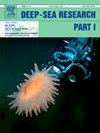地中海西部中深水Onuphidae的多样性和生物地理学(环节动物:Eunicida)
IF 2.1
3区 地球科学
Q2 OCEANOGRAPHY
Deep-Sea Research Part I-Oceanographic Research Papers
Pub Date : 2025-03-11
DOI:10.1016/j.dsr.2025.104476
引用次数: 0
摘要
从生物学的角度对地中海进行了广泛的研究,并以其高度多样性而闻名,但其深层生态系统的底栖宏观和小型动物仍未被探索。多毛类是最丰富的深海底栖无脊椎动物之一,但在分类学和生物地理学方面对它们的了解很少。Onuphidae家族以其在深海环境中的多样性而闻名,但大多数欧洲研究都集中在浅水物种上,没有在地中海100米以下深度收集的标本的分子数据。本研究对10种形态的88个标本进行了形态学表征。样本来自多恩峡谷、萨勒诺深海平原、西地中海的帕利努罗和马西利海山,以及比萨大学自然历史博物馆的历史藏品。利用串联标记16S rDNA、18S rDNA和细胞色素c氧化酶亚基i进行系统发育重建。该研究首次为地中海深海Onuphidae提供了全面的分子系统发育。结合形态学和分子数据发现了3种潜在的特有物种:Nothria sp. 1(在科西嘉岛和北第勒尼安海超过600 m深度),Nothria sp. 2 (35-90 m)和Nothria cfj . jourdei (80-230 m),并在不同深度鉴定了具有不同生物地理亲缘关系的Paradiopatra物种:P. bihanica(塞内加尔)和P. fiordica(卢西塔尼亚)。我们的研究表明,地中海浅水中南北物种范围的重叠,即所谓的“生物多样性泵”效应,也可能影响地中海深处的生物群,尽管需要对更多无脊椎动物群体进行进一步的研究。深地中海多毛类动物群可能受到邻近生物地理区域的影响,包括塞内加尔和卢西塔尼亚,但它也包括一个重要的地方性组成部分,反映了盆地独特的环境条件。在规划保护和管理这些独特而多样的生态系统时,应考虑到深海地中海动物群的这种复杂的生物地理组成。本文章由计算机程序翻译,如有差异,请以英文原文为准。
Diversity and biogeography of mesophotic and bathyal Onuphidae (Annelida: Eunicida) of the Western Mediterranean sea
The Mediterranean Sea is extensively studied from a biological point of view and known for its high diversity, however benthic macro- and meiofauna of its deep ecosystems remain largely unexplored. Polychaetes are among the most abundant deep-sea benthic invertebrates, yet they are poorly understood in terms of taxonomy and biogeography. The Onuphidae family is known for its diversity in deep-sea environments, but most European studies focus on shallow-water species, with no molecular data for specimens collected at depths below 100 m in the Mediterranean. In this study, 88 specimens from 10 morphotypes were morphologically characterised. Samples came from Canyon Dohrn, Salerno bathyal plain, and Palinuro and Marsili seamounts of the Western Mediterranean Sea, as well as from the historical collections of the Natural History Museum of the University of Pisa. Phylogenetic reconstruction was performed using concatenated markers 16S rDNA, 18S rDNA and, separately, cytochrome c oxidase subunit I. This study provides the first thorough molecular phylogeny for Onuphidae in the deep Mediterranean. The combined morphological and molecular data revealed three potentially endemic Nothria species: Nothria sp. 1 (over 600 m depth off Corsica and in the Northern Tyrrhenian Sea), Nothria sp. 2 (35–90 m), and Nothria cf. jourdei (80–230 m). This study also identified Paradiopatra species with different biogeographical affinities: P. bihanica (Senegalese) and P. fiordica (Lusitanian) at different depths. Our study reveals that the overlap of Northern and Southern species ranges in shallow Mediterranean waters, known as the "biodiversity pump" effect, may also influence the deep Mediterranean biota, though further research across more invertebrate groups is needed. The deep Mediterranean polychaete fauna is likely influenced by the neighbour biogeographic districts, including Senegalese and Lusitanian, but it also includes a significant endemic component reflecting the basin's unique environmental conditions. This complex biogeographic composition of the deep-sea Mediterranean fauna should be considered when planning conservation and management of these unique and diverse ecosystems.
求助全文
通过发布文献求助,成功后即可免费获取论文全文。
去求助
来源期刊
CiteScore
4.60
自引率
4.20%
发文量
144
审稿时长
18.3 weeks
期刊介绍:
Deep-Sea Research Part I: Oceanographic Research Papers is devoted to the publication of the results of original scientific research, including theoretical work of evident oceanographic applicability; and the solution of instrumental or methodological problems with evidence of successful use. The journal is distinguished by its interdisciplinary nature and its breadth, covering the geological, physical, chemical and biological aspects of the ocean and its boundaries with the sea floor and the atmosphere. In addition to regular "Research Papers" and "Instruments and Methods" papers, briefer communications may be published as "Notes". Supplemental matter, such as extensive data tables or graphs and multimedia content, may be published as electronic appendices.

 求助内容:
求助内容: 应助结果提醒方式:
应助结果提醒方式:


